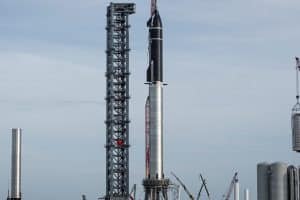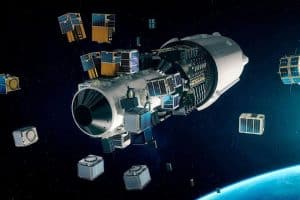Key Points
- 🚀 Rocket Lab released new concept art for its reusable Neutron rocket, showcasing design changes.
- 🛡️ The payload fairing now consists of two halves opening instead of four quarters, increasing reliability and reducing moving parts.
- 🚀 The forward strakes (fins) for steering the rocket during landing have been redesigned to provide more lift and improved maneuverability.
- 🚀 The landing legs are now folded in, similar to SpaceX’s Falcon 9 legs, and appear to deploy the same way.
- 🔍 The changes seem to be focused on appearance, while the rocket’s performance remains the same with a 9-engine first stage and a single-engine second stage.
- 📏 The Neutron rocket stands 43 meters tall, has a 7-meter diameter at the base, and tapers to a 5-meter diameter fairing at the top, aiding reentry through the atmosphere.
New concept art was released on Rocket Lab’s website today, showcasing new design choices for the company’s reusable Neutron rocket.
One of the major changes shown is how the payload fairing operates. In prior concepts, the fairing was comprised of 4 quarters that opened outward to allow second stage and payload separation. The new design shows two halves of the fairing opening.

Moving from four to two fairings will provide more reliability for the rocket and fewer moving parts.
Another change is a slight design to the forward strakes (fins) that help steer the rocket back to its landing site. Unlike SpaceX, which uses grid fins, the Neutron rocket will use fins that provide more lift and can return to the launch site from further downrange.
The forward fins also appear to have moved further up on the rocket, and the fairing halves size made a bit smaller.
Further down on the rocket, the landing legs are now folded in, similar to how Falcon 9 landing legs are folded, and appear to deploy the same way.

As of now, it appears the only changes are to the appearance, the Rocket Lab website still shows the same performance. The first stage will be powered by 9 Archimedes engines fueled by liquid methane and liquid oxygen, and 2nd stage powered by a single vacuum-optimized Archimedes engine.
Neutron stands 43 meters tall and is 7 meters in diameter at the base and slopes inwards to the top for a 5-meter diameter fairing. During an update on the rocket in December 2021, Founder and CEO Peter Beck said it would help the rocket make it back through the atmosphere by reducing the thermal load on the rocket.





